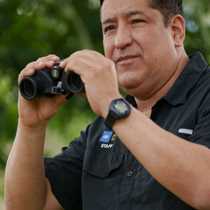Santa Cruz Island
This day of our expedition was totally dedicated to the extraordinary Gálapagos giant tortoise. We spent the morning learning about one of the longest-term and most successful conservation projects run by the world-famous Charles Darwin Research Station (CDRS) and the Galápagos National Park: the captive breeding and release program of the most emblematic Galápagos species, the giant tortoise. For a long time several giant tortoise subspecies have been at the edge of extinction caused by predation and by introduced animals. Nowadays we are proud that many tortoises are back repopulating their home islands and some of them have even started to breed successfully on their own!
During our visit to the CDRS Breeding Centre we observed tiny tortoises that are hatched and raised in captivity until they reach about four years of age and are then repatriated back to their home islands. We observed the Española Island giant tortoises as well. In this island only twelve females and two remaining males were found in the 1970’s, left over from a population that was once plentiful. These individuals, roaming on their own over the small island, unfortunately had zero breeding success due to densities that were just too low: they were therefore taken to the CDRS to be part of a long and successful repatriation program. Later on, a male from the same species was found in the San Diego Zoo, the famous “Diego,” who joined the small group very successfully, becoming the proud and prolific procreator of over half of the fourteen hundred baby tortoises that have since been repatriated to Española. Hopes are also rising to find a mate for the last known tortoise individual from Pinta Island, the popular “Lonesome George,” a search that has been going on since he was first discovered alone on his island.
After this visit we had some time to explore the town of Puerto Ayora before heading to the highlands by bus to have lunch in a local restaurant, “Altair.” Right after lunch we explored the fascinating Galápagos highlands cloud forest searching for land birds and giant tortoises in their natural habitat and visiting a couple of extraordinary geological formations, the pit craters. We even had the luck to find the most colorful of all the bird species in Galápagos, the beautiful vermillion flycatcher.
Santa Cruz Island still has a healthy population of giant tortoises in the wild. Today, some of the tortoises seemed to be literally posing for pictures. Some had perfect reflections of their whole bodies in dripping pools, creating magical moments. We left the giant tortoise territory behind, covered by the mist, heading back to town and then to the ship, dreaming on what new exciting discoveries our expedition will bring to our lives in the next days.




